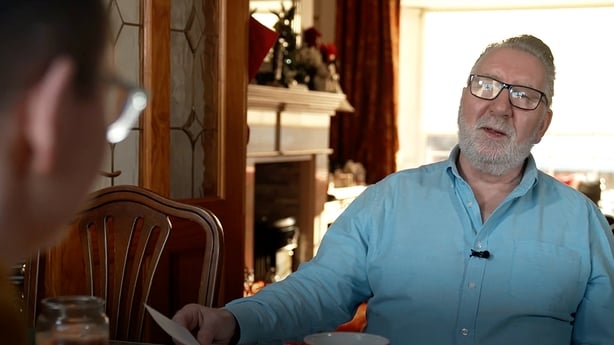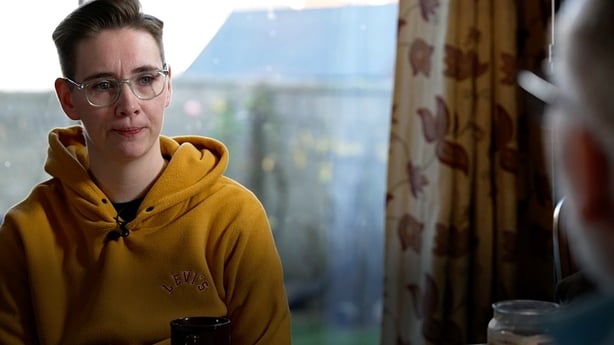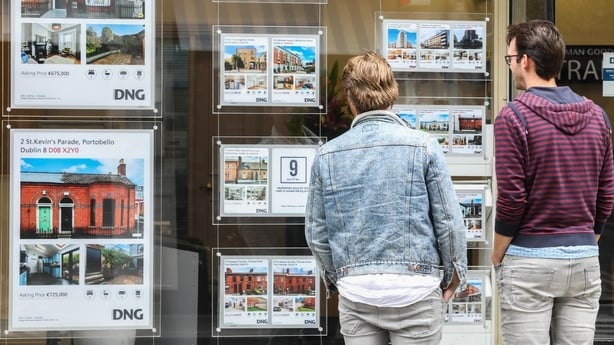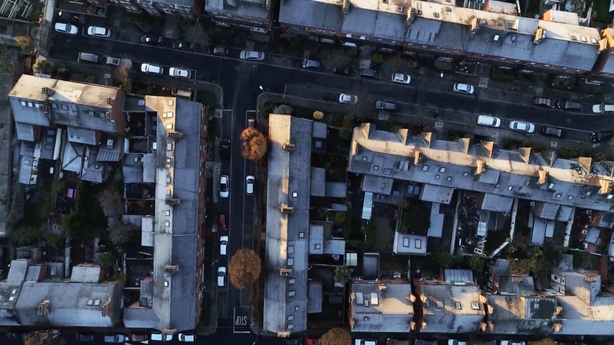Jack Byrne, 65, was 19 when he bought his first home for £17,500. He secured the mortgage with "just a pay slip" and a deposit of £3,500.
He bought his second home when he was 32, spending £27,000 on a Georgian terraced house in Dublin's Inchicore. It was a doer-upper in the true sense of the term: the upstairs flooring was unsafe and needed to be replaced, and the gas cooker in the kitchen had sunk down into the foundations.
Jack spent a lot of money on the house, but, three decades later, he is still proud that he saw its potential.
His daughter, meanwhile, is incredulous.
After a brief period of renting, Megan, 27, is back living in the family home. She has been approved for a mortgage with her partner, but, while the pair both have full-time jobs, securing one home remains elusive – never mind a second.
"It's a small but reasonable budget and we still can't get a house. We’re getting outbid or gazumped," Megan told Prime Time.
And, though the ease at which her father secured two homes is dumbfounding to Megan, Jack’s home ownership journey had more than a few bumps.
For a time, at least half of his wages went to pay the mortgage – while the earnings of his then-wife covered other household expenses.

Though he was a carpet fitter himself, Jack could not afford a full carpet for his stairs. And so he carpeted each of the 13 steps in his first home in a different colour.
But at least he had a place to call his own. Megan, on the other hand, feels like her life is on hold until she can move into her own home.
"I can't do anything. I can't change my car or whatever, because, if I do, I'll be stuck with a loan and then that will affect the amount of money I can borrow for a mortgage," she said.
Bigger milestones are also on the back burner. Megan and her partner don’t want to get engaged while they’re still living at home.
Megan’s experience is not unusual. The number of Irish people aged between 25 and 29 living with their parents grew at one of the highest rates in Europe between 2007 and 2017.
Read more:
How everything is different for today's first-time buyers
Some 45% of people in this age cohort are still living in the family home. While that’s just above the EU average, it is much higher than advanced economies like Germany, Austria and France.
Those figures back up what seems obvious to any millennial: Purchasing your own home was a lot easier for the so-called baby boomer generation.
What has been less clear is why. That’s partly because it’s a complex interplay of several factors, and accurately drawing a comparison between them over several decades is a difficult task.
But new research, which analyses property prices, incomes, taxes and mortgage rates, establishes the emergence of a staggering generation gap. It is being reported on for the first time by Prime Time.
The current generation is indeed struggling to an extent that was not the case for their parents.
The average house price in the late 1980s was €42,000. Adjusted for inflation, that is around €80,000 in today’s money. In contrast, the buyers of today spend €272,000 on average on a home.
"That represents a 230% increase in real house prices from the 1980s to 2020," said Dara Turnbull, an economist with Housing Europe, a Brussels-based social housing organisation.
We need your consent to load this Datawrapper contentWe use Datawrapper to manage extra content that can set cookies on your device and collect data about your activity. Please review their details and accept them to load the content.Manage Preferences
In the same period, wages have only increased by around 100% in real terms, meaning that earnings have not kept pace with property price increases.
"There’s been a 169% increase in mortgage repayments in real terms," Turnbull, who conducted the research, added.
Raising a deposit was significantly easier for previous generations, particularly when rent is added in to the mix.
A couple renting in 1989 would have had to save around a quarter of their disposable income, after paying rent over a year to raise a 10% deposit. Today’s couple needs to put away almost half of their equivalent income over a year to do the same thing.
If today’s pair rent in Dublin, it becomes almost impossible. They would need to save 75% of their after-rent, disposable income to get a deposit.
"If we were to include the costs of other essentials, such as food, clothing, transport, and electricity and heating, then the money left over each month to set aside for that all-important deposit is really not much," Mr Turnbull told Prime Time.

It’s little wonder that, while 83% of those in the private rental sector in Ireland or living with their parents would like to buy a home, almost half think they’ll never actually be able to do it.
Even if you can save for a deposit, the next hurdle is securing a mortgage. Most people are currently limited to borrowing 3.5 times their combined gross incomes.
The average couple’s income is €76,700, meaning that, allowing for a deposit, 3.5 times their income is just about enough to borrow 90% of the average €272,000 home.
The equivalent figures in 1987 paint a very different picture. The average dual income was €24,625, and the average house price was €42,715. So a mortgage of 3.5 times the income of the average couple would have bought you two homes – with money still left over for renovations and furnishings.
"Even if our 1980s couple only had one income, purchasing a home would have still been possible," Turnbull said.
The final hurdle for would-be homeowners is making the mortgage repayments.
Today’s couples, on average, need to pay 23% of their disposable income to cover a mortgage.
Mr Turnbull calculated that the current average disposable income is €5,176 per month. Average mortgage repayments come to €1,176 a month – meaning almost a quarter of everything earned goes to mortgage repayments. Homeowners in Dublin pay an even greater percentage of their income on a mortgage, some 28%.

In 1989, the equivalent national figure was just 15%. There was more income left over for life’s other expenses.
Mr Turnbull noted that, while mortgage interest rates were frequently north of 10% in the 1980s, inflation was also running at a high rate.
"If your interest rate was 10%, but inflation in the year was 5%, then the actual effective interest rate you were paying was 5 per cent," he said.
The scale of mortgage interest relief is also unimaginable to this generation of buyers.
A couple’s annual mortgage repayment in Dublin in 1988 would have been about €4,700 in nominal terms. But, once mortgage interest relief was taken into consideration, they would really only have paid €2,800.
Faced with harder savings, higher relative house prices and without significant mortgage interest relief, home ownership is plummeting among younger people.
In 1991, the age at which two-thirds of Irish households were homeowners was just 28. That number is 41 today – a 13-year difference.
It is possible this reflects, not just an inability to purchase a home, but also couples choosing to make other major life decisions, like getting married and having children, later in life.
But is there a chicken-and-egg situation at play?

Some research suggests that rising house prices have led to lower fertility rates for young renters, since they put off starting a family until they can afford permanent accommodation.
Studies also indicate that high house prices have had a negative impact on young peoples’ ability to start and maintain relationships.
"Clearly, the precariousness of the housing system doesn't lend itself to getting married and having a large family early on," Dr Ronan Lyons, an economist at Trinity College Dublin, told Prime Time.
But, he added, there is a strong correlation between fertility and wages.
"The higher your income is, the later you get married, and the fewer children you have.
"If you look at living standards now compared to 20 years ago, they are rising. That means we are going to get married later and have fewer children, even if the housing system was completely flexible and gave us what we wanted."
For those that do want to buy in their late 20s or 30s, the wide range of earnings in Dublin means many homes are being delivered at a price that is out of reach of a lot of workers, according to Aidan Regan, a political economist at UCD.
"Incomes are highly unequally distributed in Dublin city," he told Prime Time.

"The average wage of a Google worker is about €150,000 and, if you're in that community, of course you can afford to pay €2,000 for a one-bedroom apartment. But the average household is significantly lower than that."
"The institutional investor is not thinking about the bus driver in Blanchardstown," he said.
Mr Turnbull said that, to address the generation gap, there is a need for a greater role to be played by the State, local authorities and Approved Housing Bodies (AHBs).
Dr Rory Hearne, a social policy academic at Maynooth University and the author of Housing Shock, agrees.
"There is a European-wide housing crisis, but it's not as bad in countries like Austria. In Ireland, we have handed housing over to the private market," he told Prime Time.
"The State could be providing a significantly higher amount of supply if it wanted to."
While the solutions are a matter for policymakers, Jack and Megan continue to experience the sharp end of the problem in Naas.
"Every year that goes by, the price is going up and, right now, it feels pretty hopeless," Megan said.
"I thought you’d be long gone," Jack said. "But I think you're going to be with me for another while longer."
This week, online and on television, Prime Time is examining the issue of a generation – housing. You can read more articles in the series at rte.ie/primetime.






